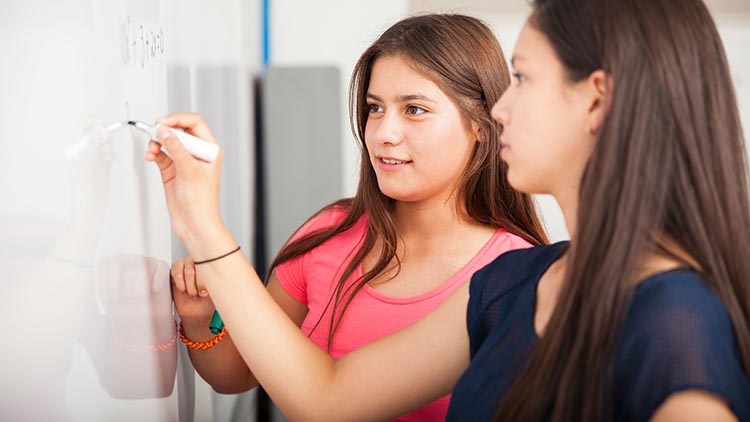
Helping students shake off negative math identities and discover how math concepts are related are some of the strategies being promoted.
From K-12 Dive
By Kara Arundel
Sept. 23, 2021
Math instruction experts say now is an optimal time to rethink how math lessons are delivered and find creative ways to empower students to develop strong understandings of numerical relationships and an appreciation for math.
After a year of virtual, hybrid or socially-distanced in-person learning, schools can provide robust math instruction by helping students focus more on the unique ways to solve math problems rather than only targeting the right answers.
Speeding through math content and failing to make connections between previously-learned concepts may do more harm than good, said Ted Coe, director of content advocacy and design at NWEA.
Students’ math performance grew at a slower rate than reading performance during the pandemic, with some attributing the slower progress to the switch to remote learning, where it was more difficult for teachers to observe students’ learning strategies. Some also said students don’t typically have natural opportunities to practice their math skills outside of class during the pandemic as they do to practice reading.
While math learning did take place last school year, the rate of progress slowed compared to previous years and in comparison to reading progress in 2020-21, according to results from NWEA’s MAP Growth assessments.
Reading achievement in spring 2021 was 3 to 6 percentile points lower than pre-pandemic achievement levels. Average math performances were worse, at 8 to 12 percentile points lower than a typical year.
Younger students, students of color and students from low-income families experienced greater dips in academic gains.
Some data also shows students who learned in virtual settings also had lower rates of progress. An analysis of math results from the Virginia Department of Education’s Standards of Learning assessment, given at the end of the 2020-21 school year, shows the average percentage of students reaching proficiency declined by 43 percentage points among predominantly virtual districts, as compared to a 28 percentage point decline for predominantly in-person districts.
These school districts are also at a lower proficiency level in the baseline year, and assessment participation statewide was at lower levels than previous years.
But those scores shouldn’t discourage teachers from implementing creative and enticing techniques for presenting math lessons, said Coe and Fenesha Hubbard, content design coordinator for the professional learning team at NWEA. In fact, this is an opportunity to repackage how students learn and demonstrate their math knowledge, they said.
Think of math as storytelling
Stories have plots, and the plot build upon details to reach a conclusion. That’s how math instruction should be presented, Coe said.
Math storytelling should not be a fragmented series of collecting procedures to make calculations, he said, but an approach that helps students focus on ways they think about solving problems.
Coe said teachers can ask students to explain why they are using a particular math strategy and what they anticipate will happen. Students can also practice verbalizing their math thinking with their peers.
“It’s almost like a math essay,” he said. “We’re trying to figure out how we can bolster these types of conversations.”
Eliminate negative math self identities
Administrators, teachers, students and parents need to stop saying they are “not math people” because that’s not true. Everyone has skills they can build upon.
“[Students] have some type of understanding, they know something about something, they’re not completely empty slates, and our job as educators is to tap into what they know while also holding them to a higher standard of where we expect them to be,” Hubbard said.
Highlighting the concepts students already know can help grow their confidence as mathematicians and lead to deeper understanding of numerical relationships.
“Nothing in the mathematics curriculum stands on its own,” Coe said. “It’s the discipline that actually makes perfect sense, but it’s the one that the students are so frequently heard saying, ‘This makes no sense at all.’”
Pause to let students learn from mistakes
Hubbard said the National Council of Teachers of Mathematics’ 5 Principles of Practice includes allowing room for trial and error in learning. Miscalculations actually help teachers pinpoint how best to help each student find different math approaches. That process can build more meaningful math connections for students.
“When we start thinking about equity and education and really taking a look at our students, what is it that we believe they deserve access to, regardless of where they are in their learning?” Hubbard said.
Collaborate with colleagues
Administrators should encourage math teachers and other school staff to collaborate with each other on these strategies, which take time to develop and perfect. They can set the tone for a math-confident school by supporting teacher professional development, hosting a math strategy session for parents, and asking students why they took a certain path to answer a math problem.
“We’re giving them the space to think through what they’re thinking, and just that breathing mental space is sometimes really the support that they need,” Hubbard said.
Photo: Edutopia
Read this and other stories at K-12 Dive

